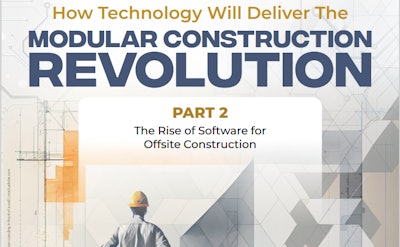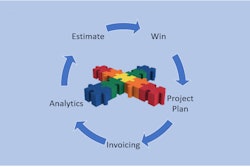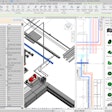
This article is part two of the FULL Report: How Technology Will Deliver the Modular Construction Revolution, a three-part series that highlights why contractors need to adopt offsite construction technology and what technology is currently available.
Use the navigation bar below to maneuver through valuable industry insight:
- PART 1: Why Contractors Need to Get Serious about Offsite Construction
- CURRENT ARTICLE - PART 2: The Rise of Software for Offsite Construction
- DOWNLOAD THE PDF *Save to your desktop for easy reading & reference
- PART 3: Offsight Builds Out ERP for Modular, Panelization and Volumetric Construction
- FULL Report: How Technology Will Deliver the Modular Construction Revolution
What unique problems do offsite, modular or panelized construction bring, and how do existing and emerging construction software products help?
Large-scale adoption of digital technologies in construction is a recent development, driven by the rise of mobile devices, cloud computing and investments in products to standardize back office functions and contain field production in a software workflow for visibility, control and efficiency.
As the industry absorbs this technological change, construction technology must also extend these digital construction workflows across shop-based production as off-site, modular, panelized and other modern methods of construction become key advantages for building teams driven to lower cost, compress timelines and reduce embodied carbon.
Construction ERP Has Some Answers
Broad project-based solutions and construction enterprise resource planning (ERP) software may address engineer-to-order manufacturing and construction has some capabilities that may be beneficial for modular. Epicor’s Kinetic product has been leveraged for offsite construction, as has Microsoft Dynamics 365 Business Central and ERP from IFS. A new ERP product launched in 2022 by Blackware Technology is designed to straddle both the construction and construction materials/component manufacturing sectors including offsite or modular construction settings.
According to Autodesk Head of Construction Strategy and Industry Partnerships Sidharth Haksar, the company behind Autodesk Build, Autodesk Construction Cloud and Revit is laying the groundwork for products that directly address offsite construction. The goal will be to help asset design come together in a process more similar to configure-to-order models in manufacturing, where a unique asset is created by configuring pre-existing parts or components. In many cases, prefabrication happens at the subcontractor or trade contractor level, and Autodesk wants to provide a common platform to specify fabricated components.
“We’ve got an incubation happening at Autodesk where what we’re trying to do is — think of the highest, simplest, way of product realization,” Haksar said. “So what we want to do is start to create a product library of components and products, so that if you’re a designer, you’re not creating and throwing an object into a model, that then the subcontractor especially looks at and says this is not designed for fabrication.
“They then have to redo the whole thing. At the end of the day, you know, there’s a finite set of products that you can end up using all the time. So, can we not provide a library upfront to the designers, so that they can end up specifying it? Then when the electrical contractor or the mechanical contractor gets it, that object is shop-ready."
Emerging Software for Offsite Construction
IRONPROS follows software for modular or offsite construction, and while ERP has been pressed into service in some of these settings, there are still gaps that must be closed to accommodate some unique processes, regulatory and logistics hurdles. But software designed specifically for portions of, or all of the offsite construction value chain are coming to market.
These products not only promise to encompass the elements missing from construction software— specifically manufacturing resource planning (MRP) for parts and materials, but labor management, shop-based scheduling in a workstation environment and quality control.
Other products focus on extending design and architectural software to coalesce better with the needs of component fabricators. An example of this may be the architect who is designing a building to be erected using precast concrete members. That designer will need to take into consideration the dimensions and characteristics of these standard parts.
QC and Inspection of Panels
One challenge of panelized construction is compliance with building codes where electrical or plumbing work must be inspected at a given point in the project. When a project relies on closed panels, the mechanical or plumbing elements to be inspected are already sealed up when they get to the construction site. We spoke to International Code Council Vice President for Innovation Ryan Colker about ICC’s partnership with Offsight Software which addresses this challenge.
“One of the benefits our partnership with Offsight offers to off-site construction is efficiency and process replicability and being able to track the project and its components,” Colker said. “Throughout the entire construction process Offsight really provides the basis for that type of tracking, following components throughout the factory and assuring that the quality assurance process is being applied.
"Offsite is offering to leverage some of the expertise from ICC NTA which is a third-party plan review and inspection agency. It works with many offsite construction manufacturers being able to integrate some of those software tools into the process and really build in that efficiency.” Colker said that panel and component manufacturers were the most natural entry point for technology to address these compliance challenges.
“The sweet point is the manufacturer themselves,” Colker said. “They’re the ones every day looking at quality assurance and those sorts of things. But I think there’s certainly utility for contractors that are working with a factory to be able to have that assurance that comes from being able to monitor where the project is, whether you have the report outputs being able to plan effectively for when different components arrive to the job site.”
Learn More with this Video Interview with Colker >>
Design for Manufacturing and Assembly (DFMA)
Taking the limitations and characteristics of individual offsite fabrication or manufacturing processes into consideration in design is one challenge Slate Technologies is addressing. The company’s current product line includes functionality that came through the May, 2022 acquisition of Splash Modular. At that time, IRONPROS debriefed former Splash Modular CEO and current Slate Technologies Vice President and Head of Industrialized Construction Joel Hutchines.
“Splash is focused on getting data in the hands of a designer to help them productize their processes,” Hutchines said. “Slate is really more focused on project managers and the general contractor. We are looking more at the data getting into the hands of the designer and using this scripting as a service model we have developed to build out a tool modular and offsite suppliers can use to productize their process and build value to generals.”
We later caught up with Hutchines on the challenges faced by building teams embarking on projects that require a thoughtful approach to DFMA.
“It’s probably worth touching on some of the limitations industrialized constructions face,” Hutchines said. “It’s based around manufacturing methodologies and manufacturing machinery which time and effort and skill sets to actually design for manufacturing and then taking the design intent and reconfiguring it. Every machine essentially takes its own input, its own code, to run. Now the process that we rarely talk about is that we have to take design intent from architectural detailing.
“We have to detail that into more complex CAD CAM to produce the code to run the machines. Now there’s a myriad of tools out there, but each one of those requires the design intent to change. There is, again often a process of re-manufacting or redesigning for the manufacturing. We address the quantified benefits of improving that to save us money. It can save us time. It can be better quality, but we rarely talk about the fact that we actually lose a lot of those efficiencies because of that process that I just described. We can actually have far more detailed insight into what the benefits of DFMA are-- if it does require extra changes in the design because you’re going to be better off. It is a big part of making sure you are delivering better.”
Learn More with these Video Interviews with Hutchines >>
Part 1
Part 2
Workface Planning
While a panel or component manufacturer or MEP contractor engaged in building out subassemblies in a shop environment may benefit from shop-based solutions, Manufacton Founder and CEO Raghi Iyenghar says ultimately, on-site and offsite teams must share a single version of the truth.
“The traditional software stack that’s been useful in construction continues to be the relevant kind at the backend,” Iyenghar said. “But what is really needed where we see things as a whole is at the workface so the people in the factory, in procurement and at the job site, all of them at the workface need to have the equivalent of a production control system in order to be able to manage what it is that they are producing, delivering and installing at that product level.”
“What is missing in terms of the tech stacks is they are traditionally more project-oriented more task-oriented rather than actually taking products through a whole lifecycle. Software needs to extend from planning and design and procurement for the materials that are needed in inventory to produce it. Software needs to address the Q&A side of it. Software needs to support getting it staged and delivered and complete the installation and do a QC. Yeah, but it needs to address that whole lifecycle for that product which could be anything that goes into that building.
Learn More with this Video Interview with Iyenghar >>
____
Full Report: How Technology Will Deliver the Modular Construction Revolution
Navigate to your next insightful repost:
- PART 1: Why Contractors Need to Get Serious about Offsite Construction
- CURRENT ARTICLE - PART 2: The Rise of Software for Offsite Construction
- DOWNLOAD THE PDF *Save to your desktop for easy reading & reference
- PART 3: Offsight Builds Out ERP for Modular, Panelization and Volumetric Construction
- FULL Report: How Technology Will Deliver the Modular Construction Revolution
____












